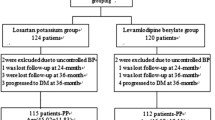Abstract
Antihypertensive drugs, recommended by the World Health Organization for use in monotherapy, exert different effects on glucose and lipid metabolism. In our study we compared the effects of the beta-blocker atenolol (AT) and the alpha1-blocker bunazosin (BU) on glucose metabolism. The doses administered were chosen to produce similar antihypertensive effects with both drugs. The study was conducted as a bicenter, parallel, controlled, and double-blind study. All patients suffered from mild to moderate primary hypertension, were obese (body mass index >26 kg/m2), but were nondiabetic. After a drug-free period of 4 weeks, patients were treated either with 6 and 12 mg of bunazosin (n = 15) or with 50 and 100 mg of atenolol (n = 17) once daily for 12 weeks. Glucose metabolism was measured by the iv glucose tolerance test (GTT) and the euglycemic hyperinsulinemic clamp test. The results show a similar blood pressure reduction with both drugs. However, their effects on glucose metabolism were significantly (p < 0.05) different: The area under the curve (AUC) of glucose in the iv GTT increased 26.8% during atenolol treatment but decreased 30% during bunazosin treatment. The same influence on the AUC of insulin was observed [AT +478.5 ± 441.8 (+22%) vs. BU, −588.5 ± 411.1 (−22%)]. Similar changes were found in the glucose clamp test. The metabolic clearance rate increased 11.4% during bunazosin use and decreased 8.4% during atenolol use to the same degree that the insulin sensitivity index changed (BU +13.2% vs. AT −21.9%). The differences between the two treatment regimes were statistically significant (p < 0.05). These results in obese hypertensives confirm the well-known negative effects of beta-blockers on glucose metabolism. Additionally, they demonstrate that an alpha1-blocker such as bunazosin develops the same blood pressure–lowering effect as beta-blockers, but with a significantly better profile with regard to glucose metabolism. Therefore, the use of alpha1-blockers can be recommended for obese hypertensives without any special care for glucose metabolism.
Similar content being viewed by others
References
Collins R, Peto R, MacMahon S, et al. Blood pressure, stroke, and coronary heart disease. Part II. Short-term reductions in blood pressure. Lancet 1990;335:827-838.
Dahlhöf B, Lindholm LH, Hansson L, Schersten B, Ekbom T, Wester PO. Morbidity and mortality in the Swedish Trial in Old Patients with Hypertension (STOP-Hypertension). Lancet 1991;338:1281-1285.
SHEP Cooperative Research Group. Prevention of stroke by antihypertensive drug treatment in older persons with isolated systolic hypertension: Final results of the systolic Hypertension in the Elderly Program (SHEP). JAMA 1991;265:3255-3264.
MacMahon S, Peto R, Cutler J, J et al. Blood pressure, stroke, and coronary heart disease. Part I. Prolonged differences in blood pressure. Lancet 1990;335:765.
Bengtsson C, Blohme G, Lapidus L, et al. Do antihypertensive drugs precipitate diabetes? Br Med J 1984;289:1495-1497.
Holzgreve H. Where now the diuretics in antihypertensive treatment? Eur Heart J 1992;13(Suppl G):104-108.
Pollare T, Lithell H, Berne C. A comparison of the effects of hydrochlorothiazide and captopril on glucose and lipid metabolism in patients with hypertension. N Engl J Med 1989;312:868-873.
Pollare T, Lithell H, Mörlin C, Präntare H, Hvarfner A, Ljunghall S. Metabolic effects of diltiazem and atenolol: Results from a randomized, double-blind study with parallel groups. J Hypertens 1989;7:551-559.
Deutsche Liga zur Bekämpfung des hohen Blutdrucks. Empfehlungen zur Hochdruckbehandlung in der Praxis und zur Behandlung hypertensiver Heidelberg: Notfälle, 1994.
Memorandum from a WHO/ISH Meeting. Guidelines for the Management of Mild Hypertension. ISH Hyperten News 1993;6:3.
Ferrannini E, Buzzigoli G, Bonadonna R. Insulin resistance in essential hypertension. N Engl J Med 1987;317:350-357.
Bönner G. Hyperinsulinemia, insulin resistance and hypertension. J Cardiovasc Pharmacol 1994;24(Suppl 2):39-49.
Bönner G, Kraus D, König K, Chrosch R, Rütten H, Krone W. Vascular reactivity to noradrenaline, angiotensin II, and bradykinin is changed by hyperinsulinemia. Circulation 1993;88(Suppl 1):359.
Landsberg L. Hyperinsulinemia: Possible role in obesity-induced hypertension. Hypertension 1992;-19:161-166.
Draznin B, Sussman KE, Eckel RH, Kao M, Yost T, Sherman NA. Possible role of cytosolic free calcium concentrations in mediating insulin resistance of obesity and hyperinsulinemia. J Clin Invest 1988;82:1848-1852.
Scherer U, Nussberger J, Torriani S. Effect of weight reduction in moderately overweight patients on recorded ambulatory blood pressure and free cytosolic platelet calcium. Circulation 1991;83:552-558.
Pollare T, Lithel H, Selenius I, Berne, C. Sensitivity to insulin during treatment with atenolol and metoprolol: A randomised, double-blind study of effects on carbohydrate and lipoprotein metabolism in hypertensive patients. Br Med J 1989;1152-1157.
Sheu WH, Swislocki AL, Hoffman B, Chen YD, Reaven GM. Comparison of the effects of atenolol and nifedipine on glucose, insulin, and lipid metabolism in patients with hypertension. Am J Hypertens 1991;4:199-205.
Bönner G, Döring R, Baumanns J, Chrosch R, Rütten H, Krone W. Endogenous kinins mediate the acute effects of ACE-inhibitors on glucose metabolism. J Hypertens 1994;12.(Suppl 3):190.
Bönner G, Rahn KH, ed ACE-Hemmer-Handbuch. Stuttgart; Schattauer-Verlag, 1994.
Bönner G. Do kinins play a significant role in the antihypertensive and cardioprotective effects of angiotensin I-converting-enzyme inhibitors? In: Laragh JH, Brenner BM ed Hypertension. New York: Raven Press, 1995:2877-2894.
Ferrera LA, DiMarino L, Russo O, Marotta T, Mancini M. Doxazosin and captopril in mildly hypercholesterolemic hypertensive patients. The Doxazosin-Captopril in Hypercholesterolemic Hypertensives Study. Hypertension 1993;21:97-104.
Author information
Authors and Affiliations
Rights and permissions
About this article
Cite this article
Bönner, G., Schmieder, R., Chrosch, R. et al. Effect of Bunazosin and Atenolol on Glucose Metabolism in Obese, Nondiabetic Patients with Primary Hypertension. Cardiovasc Drugs Ther 11, 21–26 (1997). https://doi.org/10.1023/A:1007735420758
Issue Date:
DOI: https://doi.org/10.1023/A:1007735420758




